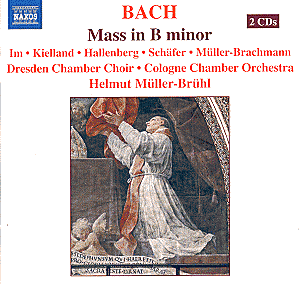I’m not sure what the point of this is. Helmut Müller-Brühl
has been around for quite a while - I remember his name gracing
the Nonesuch LP catalogue, Stateside - and his Cologne Chamber
Orchestra plays mostly modern instruments ... though I imagine
we’re hearing high trumpets in D here. But their performance
here is anything but “traditional”.
The opening invocations of “Kyrie”, polite and contained,
hardly storm the heavens but seem rather unwilling to risk disturbing
the Deity. In the main subject of the ensuing fugue, the orchestra’s
phrasing is finicky and detached - though the phrase’s continuation
as counterpoint, oddly, flows much more naturally. When the
chorus takes up the subject, they taper the lower-lying bits
nearly to inaudibility. Further mannerisms crop up as the performance
continues. The duetting ladies in the Christe, like many
period practitioners, attack in straight tone before swelling
into vibrato - but they do this on every sustained tone,
reducing the movement to note-spinning. The Et in unum Dominum
reprises the effect, exacerbating it with Sunhae Im’s pressured
flutter. Self-conscious, detached articulations rob the Qui
tollis and the Et incarnatus est of solemn gravity.
The ear strains to pick out the bashful obbligato horn in the
Quoniam. And so on and so forth.
The choral blend is good, both within and between sections,
but the consistently soft-edged sound could use some bite. In
the fugues, frankly, I’d just like to hear the entries better.
And those movements where the chorus bears the tonal responsibilities
don’t work at all. Et resurrexit, with its fast runs,
lacks presence; the Sanctus is simply murky.
The performance isn’t quite a dead loss: Et in terra
pax and Gratias agimus, for example, benefit from
going at a no-nonsense alla breve. And there’s one outstanding
soloist: Hanno Müller-Brachmann has the bass depth for the Quoniam,
and a sufficiently baritonal technique to negotiate the turns
above the staff smoothly. In the higher Et in unum sanctam
- which really dances, though the duetting oboes want
to “stick” - he’s smooth if mildly cautious. He and the acceptable
tenor avoid the ladies’ annoying straight-tone mannerisms.
Overall the enterprise is fundamentally misguided - to
use a modern orchestra and a mixed chorus to replicate the period
style, warts and all, simply squanders the advantages thereof.
In a crowded catalogue, this performance is neither fish
nor fowl. If you want this sort of performance, just
go directly for a period-instrument version. If you want to
hear what modern instruments can do in this score, Jochum’s
reverent EMI version (competitively priced, in the Double fforte
series) is beautifully sung and tonally lustrous.
Stephen
Francis Vasta
see also Review
by Peter J Lawson

![]() Sunhae
Im (soprano)
Sunhae
Im (soprano)![]() NAXOS 8.557448-49
[53.34 + 54.46]
NAXOS 8.557448-49
[53.34 + 54.46]





